Two-Stroke Shootout: Honda NSR250R Vs. Suzuki RGV250
Quarter-liter Grand Prix Dreamers the USA missed
The Honda NSR250R and Suzuki RGV250 changed the sportbike landscape all over the world – except in the USA where they sadly weren’t available due to emissions regulations. Hugely popular in Australia, Asia, Europe and the UK, these powerful two-strokes were the last of the original racer-replica era. While the rest of the world spent Sunday mornings screaming up and down local hills in two-stroke bliss, American guys and girls enjoyed four-stroke sensibility. What a shame.
It’s no secret that I’m a big fan of two-strokes. Twenty years on, I’m an older and fatter 2-stroke fan, but a recent test aboard these bikes sure made me young (but not skinny) for a day!
Sure, I own a few four-strokes and most of my racebikes have had valves and cams, but my roots are firmly planted in two-stroke territory. My first dozen or so bikes were oilers, and I went from D to A grade racing RGV250s in the mid-1990s. Believe it or not, I’d not ridden an RGV since 1996, so when this opportunity to ride the RG against Honda’s NSR, I was absolutely stoked. I decided to lock in a day at The Farm (a private 2.5-mile, 22-corner test facility near Sydney) to really make it special. Two riders and two of the coolest bikes ever on the world’s most exclusive private testing facility – pure boy racer nirvana. Now there’s a band that comes to mind when I think back to my RGV days. I was acting like a kid three days before Christmas in the lead up to the test, anticipating that powerband rush, inhaling the luscious two-stroke fumes…
Rocking up to The Farm on a perfect sunny day to find an immaculate RGV250 and an equally stunning NSR is a mindblowing experience. Close to six kilometres of tarmac perfection, brand new tires, fresh knee sliders and full fuel tanks meant the day was going to be serious fun – not to mention an absolute blast from the past. If only I could have found my Pearl Jam 1992 tour shirts to wear.
Hover your mouse over the images to learn more about the bikes’ model histories.
Honda NSR Timeline
1983 MVX250 – The three-cylinder MVX was Honda’s first attempt at a two-stroke road bike. The MVX had ATAC, an early power valve system. Downfall was the crappy VT250 chassis.
1985 NS250R – The MC11 was made in 1985 and was the leading edge two-stroke 250. It was the first V-Twin stroker proddie and had Astralite wheels, nikasil barrels and an alloy frame. 45 hp @ 9500 rpm and awesome looking!
1986 NSR250 – The MC16 was the first-ever NSR. Everything was completely new. Initially, only available in red, a blue version was released after six months. It had three-spoke wheels, a box section alloy frame and swingarm, was 44 pounds less than the MC11, and had RC exhaust valves.
1988 NSR250R – The MC18 was completely revised from its earlier brothers. It had high-swept, six-spoke wheels. The MC18 is considered the closest of the NSRs to the RS250 racer.
1990 NSR250 – The MC21 (the bike tested here) took the world by storm in 1990. It used the PGMIII ECU from the RC30, with TPS and GPS to give the ECU optimum control over ignition and the power valves. It also had a new frame and the famous Gull Arm swingarm. Both wheels were 17s, and the rear was 4.5 inches wide. SP versions were released in Cabin Racing colors (Nobu Aoki raced for the team in Japan), and had a dry clutch (as fitted to our test bike), and a close ratio gearbox. An SE version was introduced in 1991 with different wheels.
1994 NSR250R – The MC28, similar in spec to the MC21 but with the single-sided swingarm. It also had PGMIV, activated by a ‘Smart Card’. Each plastic card offered different levels of performance mapping. In reality, it was a clever system marketed by the Japanese, but really was designed to restrict the bike to meet strict Japanese emissions. It was heavier and slower than the MC21. The NSR continued unchanged until 1999. JHA then bought the remaining stock from Honda, which ran out in 2001.
Suzuki RGV Timeline
1983–1987 RG250 Gamma – An alloy framed parallel-Twin, water-cooled two-stroke that out-performed the RZ250 in almost every way but was never as popular. The 1983 model had only a bikini fairing. By 1987 the RG250 was fully faired.
1988 RGV250J – The RGV took the world by storm as Suzuki pushed the bike into many markets where the NSR was not available. The bike was a no-compromise production racer with lights. A 90º V-Twin making 67 hp @ 8,500 rpm, 282 pounds dry, 32mm Mikuni carburettors, single stage power valves, 300mm twin rotors, and Showa suspension went with the stunning GP styling.
1990 RGV250L – The L model had new, fully-adjustable rear suspension, 34mm carburetors, and new colors.
1991 RGV250M – The M model was a major update, with a banana swingarm, new forks, new shock, two-stage power valves, 17-inch wheels, revised exhaust pipes (with dual exits on the right side for more ground clearance), weight was up 22 pounds to 306 pounds, but the bike would become the most famous production racer in Australian history.
1993–1997 RGV250P – The P model had new colors and graphics, a 70º angle between cylinders, 15mm longer wheelbase, new braced swingarm, revised power valves and second/fourth gear ratios.
The Ride
Memories of riding my RGV are still fresh, and the past 17 years vanish as I fire up the red and white screamer. This could easily be 1994 when I first jumped on my M model RGV to ride home. Or 1993, when I was a first-year apprentice, and the bike shop I worked in had a secondhand red L-model RGV in the showroom that I used to lust over every morning tea break. It’s a real thrill for me. Hell, in 1989 I remember having an RGV brochure as the cover of my school folder.
The familiar rasp of the RGV pipes overlayed by that unmistakeable blender-full-of-nuts-and-bolts sound an RGV engine makes at idle turns to a crisp, deep braaaaap as I open up the 34mm Mikuni slides, and launch off towards the esses. I instantly feel at home on the RGV (even though I was 143 pounds last time I rode one, far from the 205-pound old man I am now) so I don’t feel quite as compact. In fact, a picture of a Gorilla humping an orange springs to mind.
At 282 pounds dry, the RGV is incredibly light, nimble and gives a true sportbike experience. In fact, after a lap, I’m already satisfied that it’s the best bike I’ve ridden around The Farm after the TZ250 I previously rode here once. However, I’ve yet to jump on the NSR.
Keeping the Suzuki’s sweet 90-degree Twin between 8,000 and 11,000 rpm is a buzz, and really, the bike screams. I forgot just how fast these things are, and I’m also impressed with the pull from mid-range that the single-stage power valve L model has off the slower turns. The brakes are stunning and the chassis is a dream. Even the 24-year-old shock is coping well.
I decided to ride both bikes in quick succession then swap back again for a longer test. I’m impressed with the RGV and I’m buzzing as I jump on the NSR.
The MC21 NSR is one sexy machine, and I’m really looking forward to riding it. I’ve heard so many stories about the sublime geometry and top-end kick. Just looking at the bike I feel like a factory Honda 250 GP rider!
With a lot more technology than the RGV, including an ECU similar to that on the RC30, and geometry borrowed from the RS250 and NSR250 GP bikes, I knew the NSR would be good. The bike uses a PGMIII ECU that is coupled to a throttle-position sensor and gear-position sensor. With those inputs plus rpm, the ECU monitors and controls the power valves and ignition timing to give optimum performance. Very trick stuff for 1990!
Hopping on the NSR reveals a more compact ride that feels more like a true GP bike. Mechanically, the Honda is quieter and the throttle crisper than the RGV. The rattle of the dry clutch really gets me grinning – seriously, no modern bike can replicate this kind of buzz.
The NSR chassis is simply sublime. The front end is so planted I feel as though I’m holding the front axle. Feel and feedback from the front tire is more confidence inspiring, the chassis reacts just as fast as the RGV to steering inputs but does so in a more refined and stable way, and the brakes are stunning. In every level of handling and chassis performance, the NSR is 15% better than the RGV. The engine has better peak power than the Suzuki but surprisingly doesn’t quite have the same pull off the slower corners, which means overall, on a tight circuit, the RGV would probably make a faster, although messier, lap time than the high-tech NSR.
Back on the RGV and I’m really getting stuck in now. Both are sensational and running perfectly. We’ve done dozens and dozens of laps and neither bike has missed a beat.
Pushing the RGV hard comes naturally to me. I’m scraping my entire leg – toes, ankle, calf, shin, knee – through the turns as I lean the bike over to impossible angles, carrying great corner speed as the bike gently two-wheel drifts about a foot to the outside between the apex and the exit of each turn. It’s a graceful ‘crab’ walk I remember from my proddie days – the absolute limit of an RGV. It felt good to get there, and feel so in control and comfortable – even at 40 years old. Just shows how good these little bikes are.
Back on the NSR, it’s slightly different. A faster, sweeping line through the corners with equally insane lean angle. But the Honda geometry means the NSR makes more use of the sticky tires, with more mechanical grip and no sliding aside from the odd front-end tuck into the slow esses, easily caught by digging the knee in. That’s the beauty of these old lightweight two-strokes. Try that on a modern heavy four-stroke and you’re on your arse.
The NSR is more compliant in quick changes of direction, and the suspension settles faster than the RGV set-up when flicking from full lean to full lean. Both bikes are stable on the brakes, but the NSR is slightly more composed and has more brake feel, so you can brake harder and a little deeper.
Engine-wise, I prefer the RGV. Despite the NSR’s technology and strong top-end power, its gearbox is a difficult shift and the lack of response at 8,000-9 000 rpm gives the nod to the RGV.
Chassis-wise the NSR has it all over the Suzuki, but both bikes are better than most modern machines due to their light and easy-to-manage weight. They really are from an era where us punters truly did benefit from grand prix racing. Long live the race replicas.
250cc Two-Stroke Shootout Specifications | |||
|---|---|---|---|
| 1990 Honda NSR 250 R | 1990 Suzuki RGV 250 | ||
| Claimed power | 34kW[45hp] @ 9500rpm | 43.3kW[58hp] @ 11000rpm | |
| Claimed torque | 33Nm@8500rpm | 37Nm@10800rpm | |
| Dry weight | 132kg | 128kg | |
| Fuel capacity | 16L | 17L | |
| Engine | Liquid-cooled 90° V-twin two-stroke | Liquid-cooled 90° V-twin two-stroke | |
| Bore and stroke | 54 x 54.5mm | 56 x 50.6mm | |
| Displacement | 249cc | 249cc | |
| Compression ratio | 7.4:1 | 7.5:1 | |
| Fuel delivery | Crankcase reed valve induction | Mikuni VM34SS carbs | |
| Ignition | CDI PGM-II | Suzuki Pointless Electric Ignition | |
| Exhaust | Dual HM KV3H SANKEI 2284 mufflers | Dual mufflers | |
| Ratios | 2.846, 2, 1.578, 1.333, 1.190, 1.083 | 2.454, 1.625, 1.235, 1.045, 0.916, 0.840 | |
| Final ratio | 2.667 (40/15) | 3.066 (46/15) | |
| Clutch | Wet multi-plate, with coil springs | Wet multi-plate | |
| Final drive | Chain | Chain | |
| Frame type | Twin-spar aluminium frame | Deltabox frame | |
| Swingarm | Alloy Gull-Arm swingarm | Box-section alloy | |
| Wheelbase | 1340mm | 1375mm | |
| Rake | 23° | 25.75° | |
| Trail | 87mm | 98mm | |
| Front suspension | Telescopic oil filled damper with spring preload adjustment. | Telescopic oil damped five-way adjustable forks, 120mm travel | |
| Rear suspension | Gull-Arm with external coil and damper, variable spring preload with Albach spring. | Full floating oil damped seven-way adjustable shock with Albach spring, 140mm travel | |
| Front brake | Dual floating 276mm rotors with cast aluminium four-piston calipers. | Dual 300mm rotors with four-piston calipers | |
| Rear brake | Single 220mm rotor with cast aluminium single-piston sliding caliper. | Single 210mm rotor with two-piston caliper | |
| Front wheel | Six-spoke aluminum Enkei, 110/70, 17in | Three-spoke alloy wheel, 110/70, 17in | |
| Rear wheel | Six-spoke aluminum Enkei, 150/60, 17in | Three-spoke alloy wheel, 140/60, 18in | |
| Front tyre | Pirelli Diablo Supercorsa | Bridgestone Battlax BT003F | |
| Rear tyre | Pirelli Diablo Supercorsa | Bridgestone Battlax BT003R | |
| Seat height | 770mm | 755mm | |
| Overall height | 1060mm | 1065mm | |
| Overall length | 1975mm | 2015mm | |
| Overall width | 655mm | 695mm | |
| Ground clearance | 135mm | 120mm | |
| Instruments | Analog dash | Analog dash | |
| Extras | TIGA rearsets, carbon-fiber rear hugger and heel guards, Hel braided lines. | ||
More by Jeff Ware



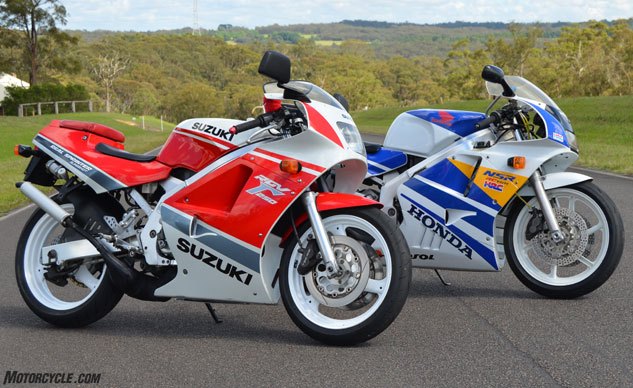
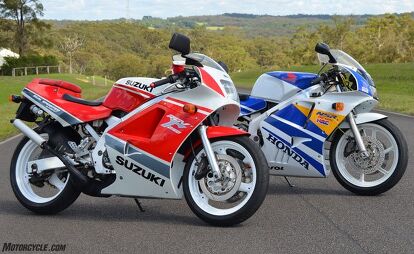

















































































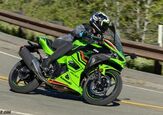
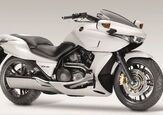

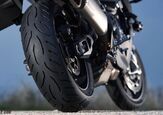
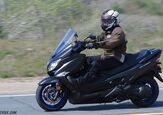
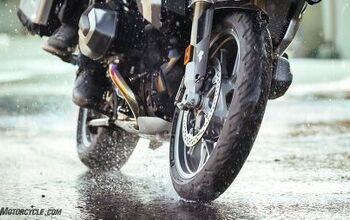
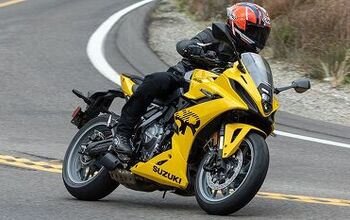

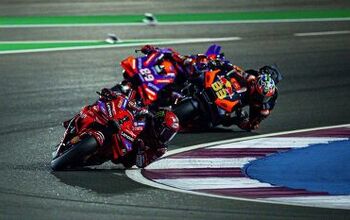

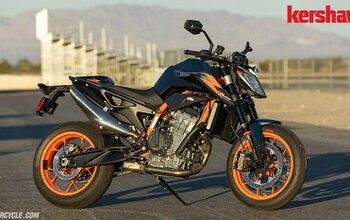

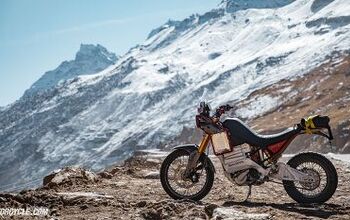
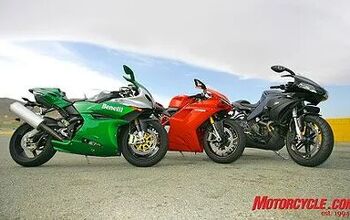
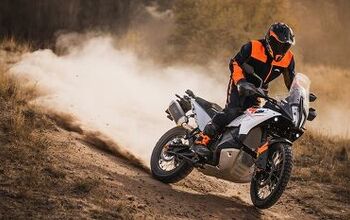
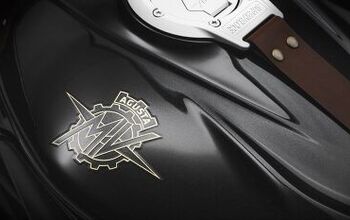
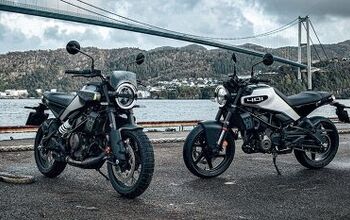
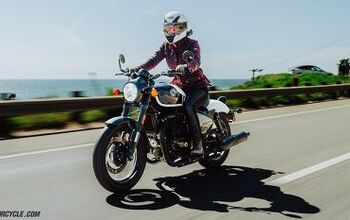
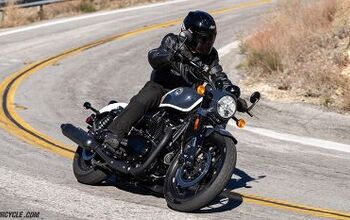
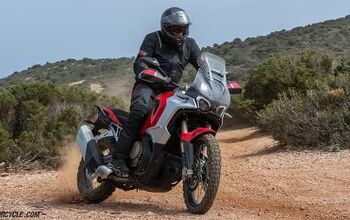
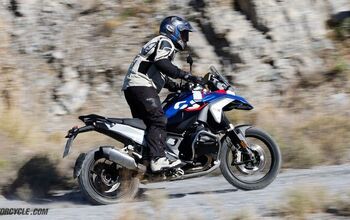
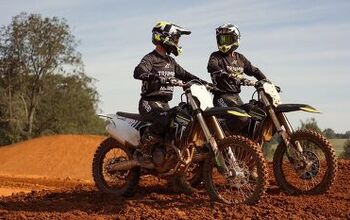
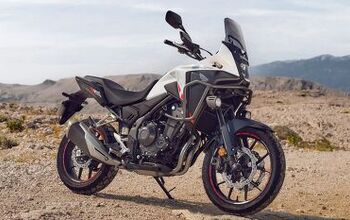
Comments
Join the conversation
Sexy bikes! They look way better than most of the bikes out now!
You hit the nail on the head. Thanks for
the sharing, I also found a useful service for forms filling. I've
forgotten the last time I filled out a form on paper. I mostly use
PDFfiller to edit. You can easily fill NJ DoR NJ-REG here http://goo.gl/bZjlgb